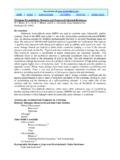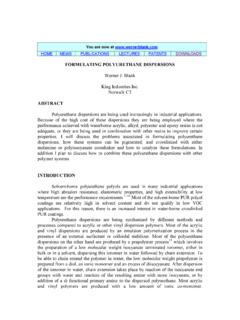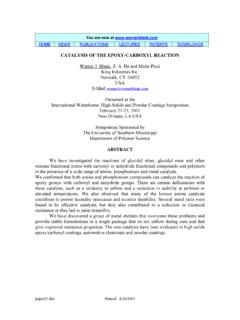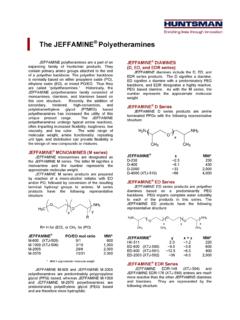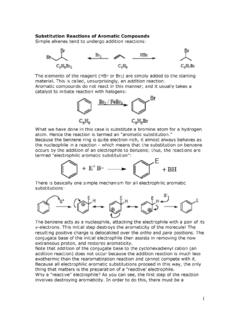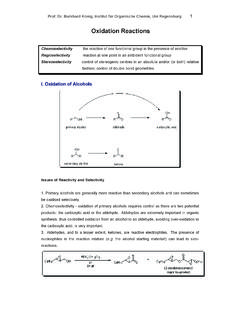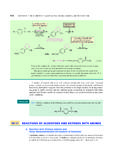Transcription of Delayed (Latent) Catalysis in Coatings - Werner Blank
1 Delayed (Latent) Catalysis in Coatings Werner J. Blank1, Kurt Dietliker2, Tunja Jung2, Caroline Lordelot2, Antoine Carroy2. 1 Consultant Wilton, CT USA, 2 Ciba, Schwarzwaldallee 215, CH-4002 Basel, Switzerland INTRODUCTION Most industrial crosslinked Coatings require Catalysis . The rate of the crosslinking reaction has to be adjusted to the application, application method and to customer s requirements. An ideal catalyst would give excellent stability, a long potlife and high reaction rate when required. Most of the catalyzed Coatings follow an Arrhenius rate. Depending on the nature of the crosslinking reaction and the reaction mechanism many different approaches are used to either delay Catalysis or to achieve latency outright. The foremost approaches taken are blocking of the catalyst or creating the catalyst in situ.
2 Blocking of Catalyst Blocking groups for the catalysts can be deactivated by evaporation after application, by reaction, by rearrangement or by some other event such as radiation or oxidation. The choice of the deblocking mechanism has to be carefully selected as not to interfere with the overall performance of the catalyst. Acid Catalysis is used with amino-formaldehyde and epoxy crosslinking. For fully alkylated HMMM type melamine resins acid catalysts with a pKa value of <1 are used, for epoxies, especially cycloaliphatic epoxies superacid catalysts. Amine blocking can be used for both types of acid Catalysis . For melamine resins it was found that pKa value, boiling point, and structure of the amine have an effect on the stability of the coating formulation, rate of cure and film performance.
3 Initial assumptions that amine evaporation is the major mode of activation of the acid catalyst were found incorrect. As a matter of fact, evaporation of the amine-blocking agent can lead to problems with film appearance such as wrinkling and low gloss. Reduction in pKa value of primary and secondary amines by reaction with formaldehyde is one of the major modes of amine In addition low pKa value t-amines show a substantial reduction in pKa at higher temperature. Blocking of superacid catalysts with primary, secondary or t-amines slows the catalytic activity of epoxy reaction somewhat, more effective are quaternary ammonium compounds. Deactivation of the quaternary ammonium compound can be achieved thermally2 or by UV radiation3. For metal catalysts such as organotin Lewis acids, and Al, Zr, La dionate complexes for isocyanate Catalysis blocking can be achieved with excess of a 1,3-dionate chelating agent such as 2,4-pentanedione or similar complexes.
4 One proposed mechanism for these catalysts is exchange with the hydroxyl groups leading to an alkoxy intermediate, which in turn reacts with the isocyanate via an insertion Excess of the dionate chelate shifts the equilibrium to the complex and hinders the formation of the alkoxy intermediate. After application the evaporation of the chelate activates the catalyst. These catalysts give improved potlife without substantially effecting catalytic activity. A similar approach is being taken in air-drying applications of unsaturated oils or alkyds where oximes are used to chelate the oxidation catalysts and thus prevent skin formation. Acid blocking groups for epoxy catalysts such as amine or Zn compounds can be removed by reaction with the Base catalysts for the epoxy6 or isocyanate reaction7 are Delayed by neutralization.
5 The degree of delay is directly related to the acid strength. Formation of amine salt complexes is one approach to delay epoxy reaction. Thermal In Situ Catalyst Formation For many applications the use of a catalyst precursor that permits the formation of the catalyst after application, by heat, radiation or another external event is a better approach than blocking of an existing catalyst. Acid catalysts for amino resins can be formed from the sulfonic ester precursor by thermal decomposition of the alkyl ester or by hydrolysis. Because no amine is evolved during cure, the coating films tend to give higher gloss and distinction of image. Metal catalysts can be formed in situ from nano dispersions of oxides and carboxylic acids. Bi carboxylates hydrolyze in presence of trace amount of water and form catalytically inactive specie.
6 Addition of isocyanate leads to a reforming of the bismuth carboxylate and Delayed Similarly in blocked isocyanate electrocoating applications heating of the fine dispersed Bi oxide in the presence of carboxyl groups reforms Bi Triphenylbismuth is used as Delayed catalyst10 in casting of polyurethane solid rockets. Triphenylbismuth itself does not catalyze the isocyanate-hydroxyl reaction, but rather is hydrolyzed in presence of acid to a bismuth salt, which functions as catalyst. Tetraorganostannanes11 of the type of bis-[2-(acyloxy)alkyl]diorgano- stannanes, are non-catalytic tin compounds which can be heat-activated by anti -elimination reaction leading to catalytically active bis(acyloxy) For many applications, activation at room temperature is required. 1,2-Bis(acyloxy)tetraalkyldistannanes are easily oxidized in air to 1,3-bis(acyloxy) tetraalkyldistannoxanes, which is a proven catalyst for polyurethane Hydroxylamides synthesized from piperidine with ?
7 -butyrolactone and phthalide have shown to thermally dissociate to amine and catalyze the epoxy Phosphonic amide esters also function as thermally latent anionic initiators in the polymerization of glycidyl epoxies15. Imidazoles blocked by reaction with an isocyanate function as latent catalysts for epoxy In situ generated amines for the cure of epoxy resins can also be generated from the thermal decomposition of 1,1,3-substituted Photoinduced Catalyst Release Light induced generation of a catalyst from a suitable precursor is a very useful means for the in situ generation of the active catalyst. Since the active species is produced by a photochemical reaction, this reaction step is not subject to the Arrhenius rate control. Thus a very long potlife of the formulation is achieved when stored in the dark.
8 This cure on demand is a typical advantage of radiation curable formulations, which is not matched by other latency concepts. On the other hand, the use of light as trigger gives rise to some limitations especially if pigmented or highly filled formulations are to be cured. Photodecomposition of oxime sulfonate ester18 can produce free sulfonic acids. Oxime sulfonic acid esters are thermally stable up to a temperature of 180 C. This chemistry is used in photoresists and micro lithography and both compounds sensitive to deep UV light (KrF laser, 248 nm, ArF laser 193 nm) and long wavelengths (i-, h- an g-line) are available. coating applications using the same chemistry are also being Strong superacids are produced from onium salt precursors20,21 which in contrast to the neutral oxime sulfonates are ionic compounds.
9 The compounds are mainly used for the curing of epoxy or vinyl ether based formulations. Sulfonium salts are in widespread use, but since iodonium salts can be more efficiently sensitized, they are preferred when light of long wavelengths has to be used for activation, as it is for example the case for white pigmented More recently photolatent amine catalysts have become the focus of much interest. In fact, tertiary amines are capable to catalyze a wide variety of different crosslinking reactions, including the alcohol-isocyanate addition, the Michael addition, the ring opening of epoxides by nucleophiles such as amines, thiols, carboxylates or anhydrides, or siloxane condensation reactions. The photochemical generation of primary or secondary amines is well known and has been used both in resist23 and coating These amines usually act as crosslinkers but are not suitable as real catalysts.
10 Hence only the recent development of photolatent tertiary amines opened the way to real light-triggered base-catalyzed reactions. Photocleavage of -aminoketone photoinitiators produces both efficient initiating radicals and a tertiary amine. The latter is formed from a sterically encumbered precursor of much lower efficiency as an amine catalyst. Thus the concept of photoinduced steric release can be used for the design of photolatent tertiary ,26 A first application is photolatent tertiary amine catalysts used in a car refinish formulation based on the thiol/isocyanate addition For many crosslinking reactions, amines of a stronger basicity are required for efficient Catalysis . DBN ( [ ]nonane) is an exceptional strong base with a pKa-value of It can be photochemically released by photoinduced oxidation of a weak basic N-benzylated precursor (pKa ).

